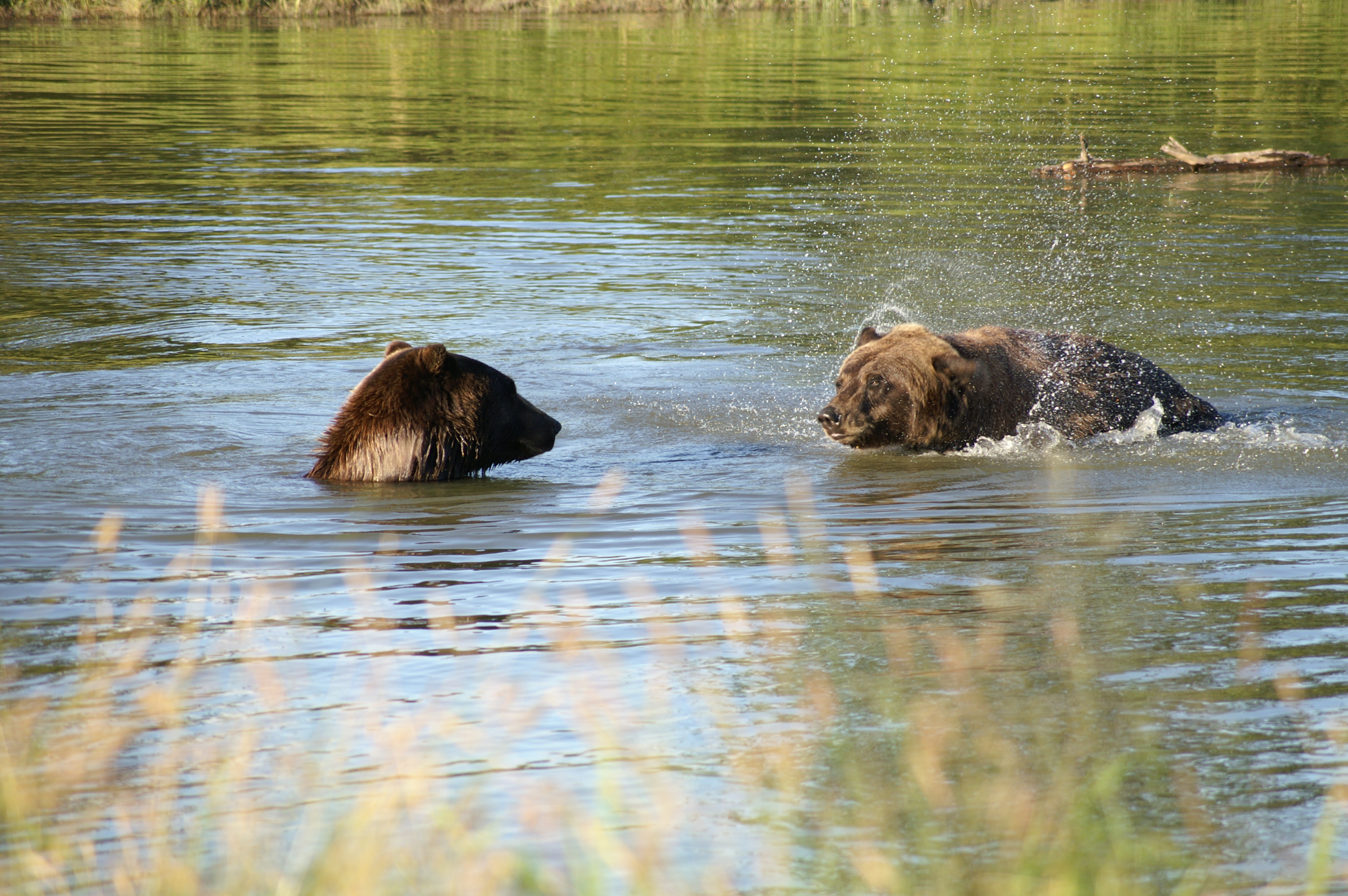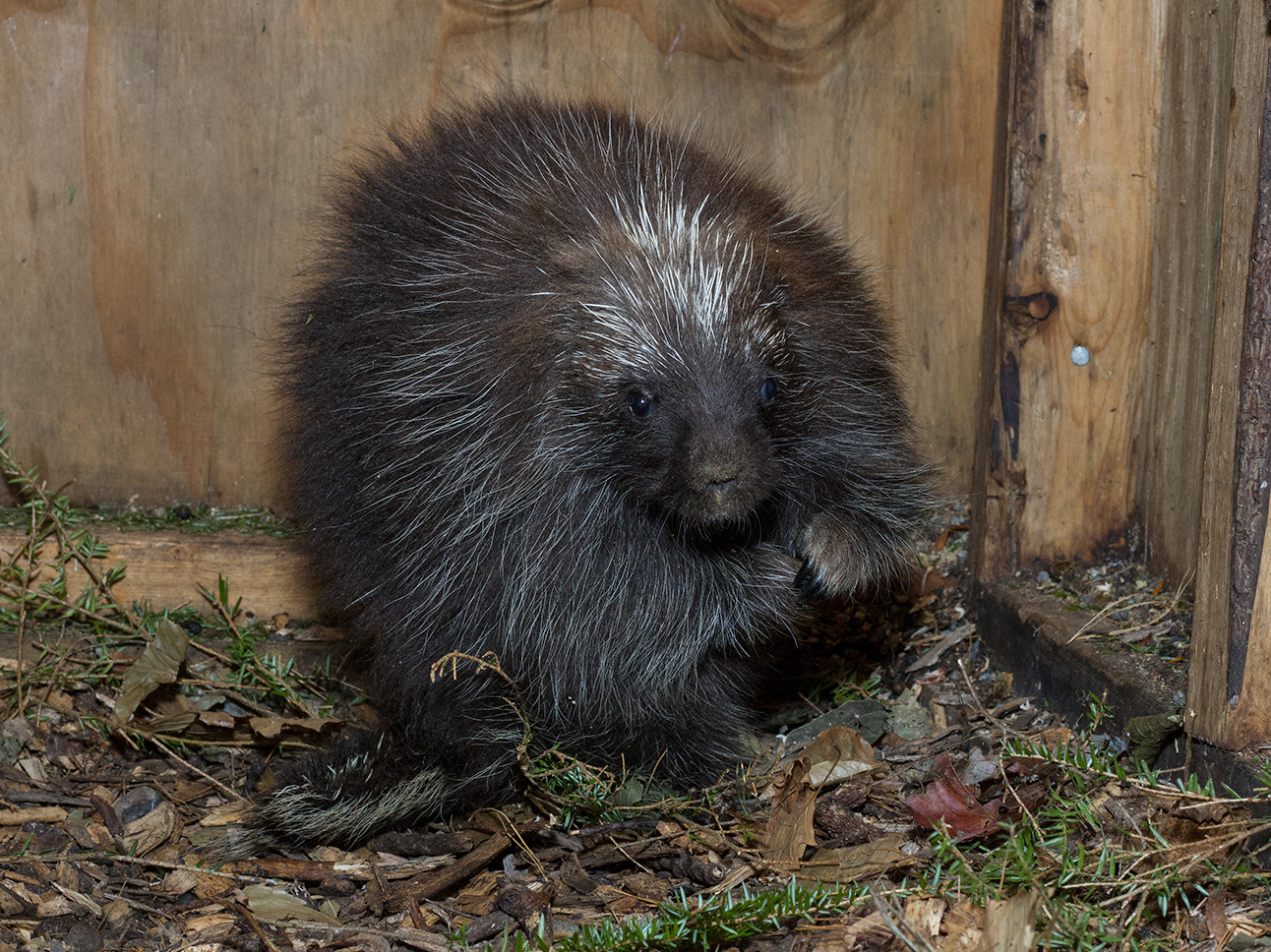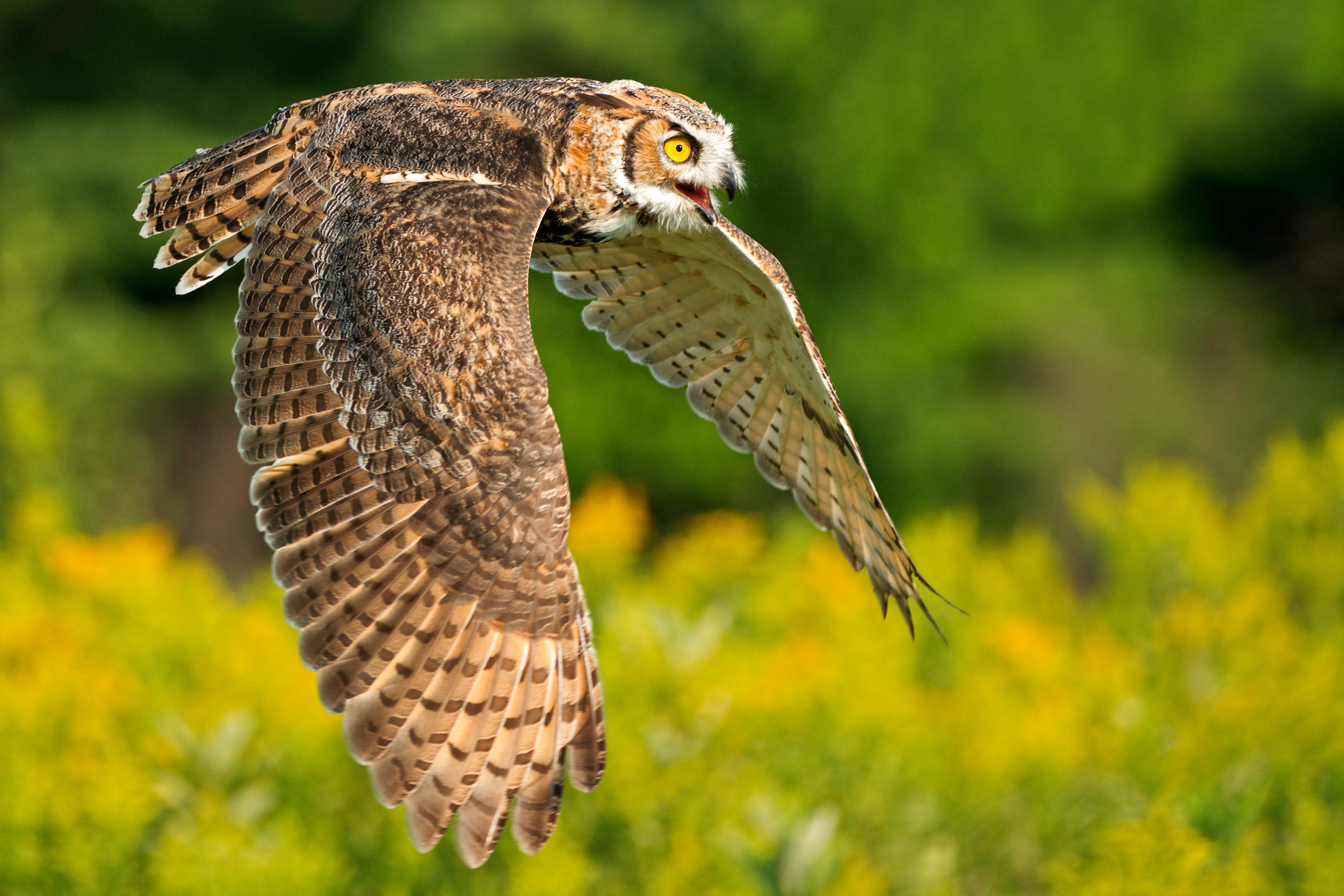|
Alaska Wildlife Conservation Center
The Alaska Wildlife Conservation Center is a non-profit organization dedicated to conservation, research, education, and animal care. The center is located on about at the head of Turnagain Arm and the entrance to Portage Valley, Milepost 79 of the Seward Highway, about 11 mi southeast of Girdwood. The center is in the Municipality of Anchorage on the approximant border of the Kenai Peninsula and the Kenai Mountains to the south and the Chugach Mountains to the north. It is a wildlife sanctuary for orphaned or injured wildlife, as well as home or temporary home to captive born and translocated wildlife such as wood bison. It is a wildlife sanctuary that provides comfortable, permanent homes for orphaned and injured animals. History The Alaska Wildlife Conservation Center opened in 1993 as the for-profit Big Game Alaska. In 1999, the center became a 501(c)3 non-profit organization, with Mike Miller serving as the center's executive director. The name was officially change ... [...More Info...] [...Related Items...] OR: [Wikipedia] [Google] [Baidu] |
Wood Bison
The wood bison (''Bison bison athabascae'') or mountain bison (often called the wood buffalo or mountain buffalo), and Athabaskan bison (or Athabaskan buffalo), is a distinct northern subspecies or ecotype of the American bison. Its original range included much of the boreal forest regions of Alaska, Yukon, western Northwest Territories, northeastern British Columbia, northern Alberta, and northwestern Saskatchewan.Wood Bison Restoration in Alaska Alaska Department of Fish & Game, Division of Wildlife Conservation Name The term "buffalo" is considered to be a for this animal, as it is only distantly related to either of the two "true buffalo", the |
American Black Bear
The American black bear (''Ursus americanus''), or simply black bear, is a species of medium-sized bear which is Endemism, endemic to North America. It is the continent's smallest and most widely distributed bear species. It is an omnivore, with a diet varying greatly depending on season and location. It typically lives in largely forested areas; it will leave forests in search of food and is sometimes attracted to human communities due to the immediate availability of food. The International Union for Conservation of Nature (IUCN) lists the American black bear as a least-concern species because of its widespread distribution and a large population, estimated to be twice that of all other bear species combined. Along with the brown bear (''Ursus arctos''), it is one of the two modern bear species not considered by the IUCN to be globally threatened with extinction. Taxonomy and evolution The American black bear is not closely related to the brown bear or polar bear, though all ... [...More Info...] [...Related Items...] OR: [Wikipedia] [Google] [Baidu] |
Elk Island National Park
Elk Island National Park is a National Parks of Canada, national park in Alberta, Canada, that played an important part in the conservation of the plains bison. The park is administered by the Parks Canada Agency. This "island of conservation" is east of Edmonton, along the Yellowhead Highway, which goes through the park. It is Canada's eighth smallest in area but largest fully enclosed national park, with an area of . The park is representative of the northern prairies plateau ecosystem and as such, the knob and kettle landscape is a mix of native fescue grassland that has been converted to forage land dominated by non-native grasses, aspen parkland and boreal forest. As well, Elk Island hosts both the largest and the smallest terrestrial mammals in North America, the wood bison and American Pygmy Shrew, pygmy shrew respectively. History Elk Island National Park is situated in the Beaver Hills (Alberta), Beaverhills area, which with its aspen thickets and easy access to w ... [...More Info...] [...Related Items...] OR: [Wikipedia] [Google] [Baidu] |
Education
Education is the transmission of knowledge and skills and the development of character traits. Formal education occurs within a structured institutional framework, such as public schools, following a curriculum. Non-formal education also follows a structured approach but occurs outside the formal schooling system, while informal education involves unstructured learning through daily experiences. Formal and non-formal education are categorized into levels, including early childhood education, primary education, secondary education, and tertiary education. Other classifications focus on teaching methods, such as teacher-centered and student-centered education, and on subjects, such as science education, language education, and physical education. Additionally, the term "education" can denote the mental states and qualities of educated individuals and the academic field studying educational phenomena. The precise definition of education is disputed, and there are ... [...More Info...] [...Related Items...] OR: [Wikipedia] [Google] [Baidu] |
Coyote
The coyote (''Canis latrans''), also known as the American jackal, prairie wolf, or brush wolf, is a species of canis, canine native to North America. It is smaller than its close relative, the Wolf, gray wolf, and slightly smaller than the closely related eastern wolf and red wolf. It fills much of the same ecological niche as the golden jackal does in Eurasia; however, the coyote is generally larger. The coyote is listed as Least Concern, least concern by the International Union for Conservation of Nature, due to its wide distribution and abundance throughout North America. The species is versatile, able to adapt to and expand into environments modified by humans; urban coyotes are common in many cities. The coyote was sighted in eastern Panama (across the Panama Canal from their home range) for the first time in 2013. The coyote has 19 recognized subspecies. The average male weighs and the average female . Their fur color is predominantly light gray and red or fulvous int ... [...More Info...] [...Related Items...] OR: [Wikipedia] [Google] [Baidu] |
North American Porcupine
The North American porcupine (''Erethizon dorsatum''), also known as the Canadian porcupine, is a large quill-covered rodent in the New World porcupine family. It is the second largest rodent in North America after the North American beaver (''Castor canadensis''). The porcupine is a Caviomorpha, caviomorph rodent whose ancestors were believed to have Oceanic dispersal, crossed the Atlantic from Africa to Brazil 30 million years ago, and then migrated to North America during the Great American Interchange after the Isthmus of Panama rose 3 million years ago. Etymology The word "porcupine" comes from the middle or old French word , which means 'thorn pig'. Its roots derive from the Latin words or pig and meaning thorns. Other colloquial names for the animal include quill pig. It is also referred to as the Canadian porcupine or common porcupine. The porcupine's scientific name, ''Erethizon dorsatum'', can be loosely translated as "the animal with the irritating back". Indigenous t ... [...More Info...] [...Related Items...] OR: [Wikipedia] [Google] [Baidu] |
Great Horned Owl
The great horned owl (''Bubo virginianus''), also known as the tiger owl (originally derived from early naturalists' description as the "winged tiger" or "tiger of the air") or the hoot owl, is a large owl native to the Americas. It is an extremely adaptable bird with a vast range and is the most widely distributed true owl in the Americas. Its primary diet is Leporidae, rabbits and hares, New World rats and mice, rats and mice, and voles, although it freely hunts any animal it can overtake, including rodents and other small mammals, larger mid-sized mammals, birds, reptiles, amphibians, and invertebrates. In ornithological study, the great horned owl is often compared to the Eurasian eagle-owl (''Bubo bubo''), a closely related species, which occupies the same ecological niche in Eurasia despite its notably larger size. The great horned owl is also compared to the red-tailed hawk (''Buteo jamaicensis''), with which it often shares similar habitat, prey, and nesting habits by day ... [...More Info...] [...Related Items...] OR: [Wikipedia] [Google] [Baidu] |
Bald Eagle
The bald eagle (''Haliaeetus leucocephalus'') is a bird of prey found in North America. A sea eagle, it has two known subspecies and forms a species pair with the white-tailed eagle (''Haliaeetus albicilla''), which occupies the same niche as the bald eagle in the Palearctic. Its range includes most of Canada and Alaska, all of the contiguous United States, and northern Mexico. It is found near large bodies of open water with an abundant food supply and old-growth trees for nesting. The bald eagle is an opportunistic feeder that subsists mainly on fish, upon which it swoops down and snatches from the water with its talons. It builds the largest nest of any North American bird and the largest tree nests ever recorded for any animal species, up to deep, wide, and in weight. Sexual maturity is attained at the age of four to five years. Bald eagles are not bald; the name derives from an older meaning of the word, "white-headed". The adult is mainly brown with a white head ... [...More Info...] [...Related Items...] OR: [Wikipedia] [Google] [Baidu] |
Canada Lynx
The Canada lynx (''Lynx canadensis'') or Canadian lynx is one of the four living species in the genus ''Lynx''. It is a medium-sized wild cat characterized by long, dense fur, triangular ears with black tufts at the tips, and broad, snowshoe-like paws. Its hindlimbs are longer than the forelimbs, so its back slopes downward to the front. The Canada lynx stands tall at the shoulder and weighs between . It is a good swimmer and an agile climber. The Canada lynx was first scientific description, described by Robert Kerr (writer), Robert Kerr in 1792. Three subspecies have been proposed, but their valid name (zoology), validity is doubted; it is mostly considered a monotypic species. It ranges across Alaska, Canada and northern areas of the contiguous United States, where it predominantly inhabits dense Taiga, boreal forests. It is a Specialist and generalist species, specialist predator and depends heavily on the snowshoe hare (''Lepus americanus'') for food. This leads to a Lot ... [...More Info...] [...Related Items...] OR: [Wikipedia] [Google] [Baidu] |
Porcupine Caribou
The Porcupine caribou is a herd or ecotype of the mainland barren-ground caribou (''Rangifer arcticus arcticus'', Synonym (taxonomy), syn. ''R. tarandus groenlandicus''Harding LE (2022) Available names for Rangifer (Mammalia, Artiodactyla, Cervidae) species and subspecies. ZooKeys 1119: 117–151. doi:10.3897/zookeys.1119.80233.), the subspecies of the reindeer or caribou found in Alaska, United States, and Yukon and the Northwest Territories, Canada. Migratory caribou herds are named after their calving grounds, in this case the Porcupine River, which runs through a large part of the range of the Porcupine herd. Though numbers fluctuate, the herd comprises about 218,000 animals (based on a July 2017 photocensus). They migrate over a year between their winter range and calving grounds at the Beaufort Sea, the longest land migration route of any land mammal on Earth. Their range spans the Alaska-Yukon border and is a valued resource cooperatively managed by the Alaska Department o ... [...More Info...] [...Related Items...] OR: [Wikipedia] [Google] [Baidu] |
Sitka Deer
The Sitka deer or Sitka black-tailed deer (''Odocoileus hemionus sitkensis'') is a subspecies of mule deer (''Odocoileus hemionus''), similar to the black-tailed deer, Columbian black-tailed subspecies (''O. h. colombianus''). Their name originates from Sitka, Alaska, and it is not to be confused with the similarly named sika deer. Weighing in on average between , Sitka deer are characteristically smaller than other subspecies of mule deer. Reddish-brown in the summer, their coats darken to a gray-brown in mid- to late August. They are also good swimmers, and can occasionally be seen crossing deep channels between islands. Their average lifespan is about 10 years, but a few are known to have attained an age of 15. Habitat and life patterns Sitka deer inhabit the coastal rainforests of northern British Columbia and southeastern Alaska. Their natural distribution included the Alexander Archipelago in Alaska and the adjacent mainland coast north to Yakutat. They were also introd ... [...More Info...] [...Related Items...] OR: [Wikipedia] [Google] [Baidu] |
Muskox
The muskox (''Ovibos moschatus'') is a hoofed mammal of the family Bovidae. Native to the Arctic, it is noted for its thick coat and for the strong odor emitted by males during the seasonal rut, from which its name derives. This musky odor has the effect of attracting females during mating season. Its Inuktitut name "umingmak" translates to "the bearded one". Its Woods Cree names "mâthi-môs" and "mâthi-mostos" translate to "ugly moose" and "ugly bison", respectively. In historic times, muskoxen primarily lived in Greenland and the Canadian Arctic of the Northwest Territories and Nunavut. They were formerly present in Eurasia, with their youngest natural records in the region dating to around 2,700 years ago, with reintroduced populations in the American state of Alaska, the Canadian territory of Yukon, and Siberia, and an introduced population in Norway, part of which emigrated to Sweden, where a small population now lives. Evolution Extant relatives The muskox i ... [...More Info...] [...Related Items...] OR: [Wikipedia] [Google] [Baidu] |









